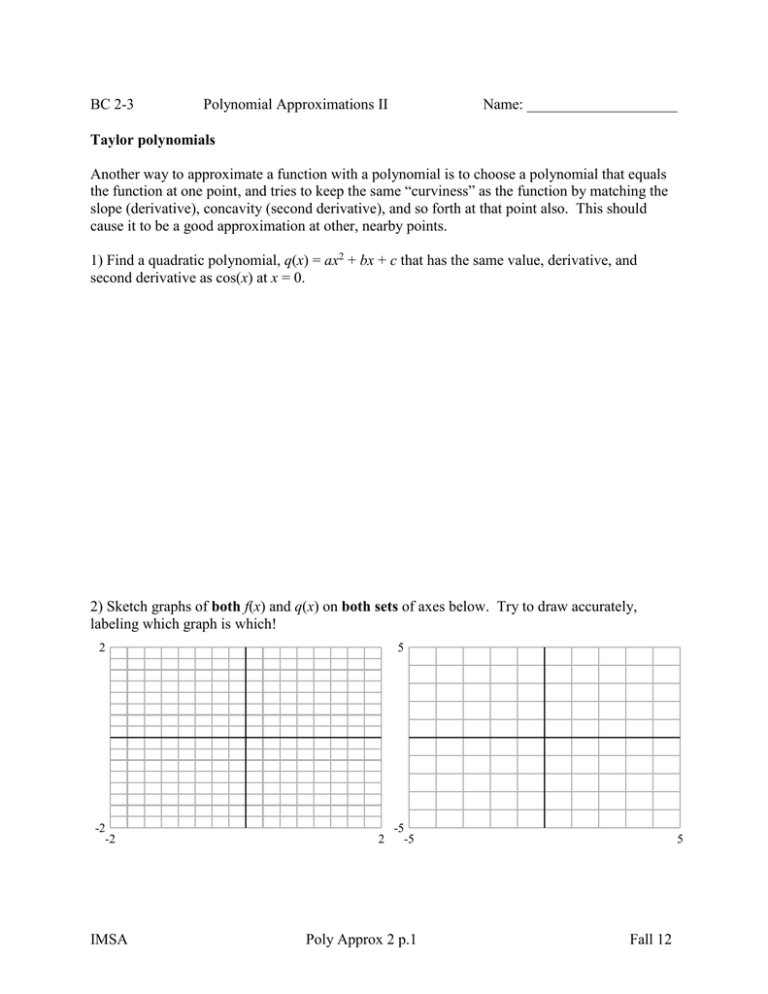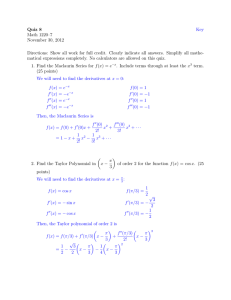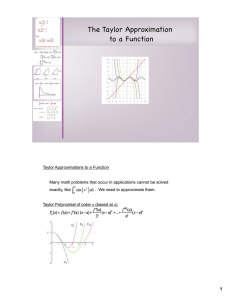Poly Approx II
advertisement

BC 2-3 Polynomial Approximations II Name: ____________________ Taylor polynomials Another way to approximate a function with a polynomial is to choose a polynomial that equals the function at one point, and tries to keep the same “curviness” as the function by matching the slope (derivative), concavity (second derivative), and so forth at that point also. This should cause it to be a good approximation at other, nearby points. 1) Find a quadratic polynomial, q(x) = ax2 + bx + c that has the same value, derivative, and second derivative as cos(x) at x = 0. 2) Sketch graphs of both f(x) and q(x) on both sets of axes below. Try to draw accurately, labeling which graph is which! 2 -2 -2 IMSA 5 2 -5 -5 Poly Approx 2 p.1 5 Fall 12 3) Why is the second graph so much worse-looking an approximation than the first? Taylor polynomials are polynomials that exactly match the function and its first few derivatives at a single point, hoping that it will make a good approximation at other, nearby points. It does a pretty good job in general. 4) If we use the first degree Taylor polynomial to approximate a function at a point, what familiar thing are we doing? 5) If we wish to use n derivatives, explain why we can always use a polynomial whose degree is n (or less). 6) Find the fourth degree polynomial that matches the value and first four derivatives of cos(x) at x = 0. (Hint: write the polynomial as a0 + a1x + a2x2 + a3x3 + a4x4. Plug in x = 0 and solve for a0. Differentiate, plug in x = 0 and solve for a1, and so on.) IMSA Poly Approx 2 p.2 Fall 12 7) Plot cos(x) and your fourth-degree Taylor polynomial together. Choose a couple of different ranges to get an idea of where the polynomial is a good approximation and where it isn’t. Label your graphs! 8) Could the Taylor polynomial be used in calculus applications? Evaluate its derivative at x = 1, and its integral from 0 to 1. Compare to the exact values you would obtain for cos(x). 9) Which did you think was a better approximation, the Taylor polynomial or the interpolating polynomial? Explain the criteria you used to make your decision. 10) Which are easier to work with? Why? IMSA Poly Approx 2 p.3 Fall 12 11) How easy is it to improve the accuracy of the interpolating polynomial by adding more interpolation points? How easy is it to improve the accuracy of Taylor polynomials by adding more derivatives? 12) Find the interpolating polynomial for f(x) = ex, interpolated at x = -1, 0, 1. 13) Find the Taylor polynomial for f(x) = ex matching the first two derivatives. 14) Which of the above is a better approximation to f(x) = ex on the interval [-1, 1]? On what criteria are you basing this judgment? IMSA Poly Approx 2 p.4 Fall 12



![Student number Name [SURNAME(S), Givenname(s)] MATH 100, Section 110 (CSP)](http://s2.studylib.net/store/data/011223986_1-37c276ae41f28d5dba87bc6d27e2a5b3-300x300.png)

